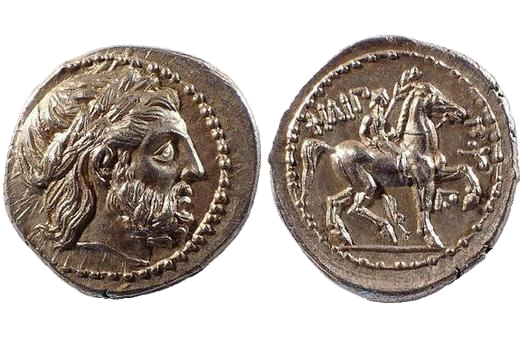
about ancient nomos
Ancient Nomos Art is a museum of galleries exhibiting ancient coins and ancient mint maps. The coin gallery displays the diverse art and history of hand-crafted ancient Greek, Roman, Byzantine, Persian and Medieval coinage. The ancient mints mapping gallery features Greek, Roman, Byzantine, Asia Minor and Medieval mint city regions and territories. Visitor's are welcome to explore, study and enjoy Ancient Nomos Art.

Greek, Amphipolis – 359 BC
King Philip II
From Ancient Galleries

Obverse: Laureate head of bearded Zeus with bust facing right, beaded border.
Reverse: Youth on horse holding palm in right hand, rein in left; apluster below.
LEGEND SYMBOLS
Obv. Laureate head of Zeus facing right, within beaded border. Rev. ΦΙΛΙΠ-ΠΟΥ, Jockey or “Youth on horseback” right, holding palm frond in right hand, rein in left; aphlaston below, pellet • in Π under raised foreleg.
Ancient Macedonia is located north of the mainland Greek peninsula and continues into the mountainous region south of the Balkans. Early Macedonia was ruled by Dorians in the 7th century, but was also a diverse region that included Greek, Illyrian and Thracian populations. The next few centuries were influenced by a strong Hellenic dominance. Philip was born in 382 BC, son to the Macedonian King Amyntas II. Beginning at the age of 15, Philip was held hostage by the Greeks at Thebes where this unlikely misfortune gained him his knowledge, culture and military training. After release, Philip was appointed regent by Amyntas, but soon plotted to seize the throne for himself in 356 BC. His famous son Alexander III was born the same year. Philip’s military skill and tactics suppressed most of his opponents, while his diplomatic finesse united the many principalities of Macedonia and ultimately expanded territories eastward into Thrace. The vast gold mines of Thrace and silver in Macedon allowed Philip to issue vast quantities of coinage. His coins convey powerful images of Zeus that are believed to be portraits in his likeness. The above coin was issued posthumously in 323 BC at the Amphipolis mint. The obverse depicts the fully bearded bust of Zeus facing right, while wearing a detailed laureate wreath. Small wild berries can be seen alternating between the leaves. The coin’s reverse displays a young man on horseback, perhaps his son Alexander or Macedon Jockey, prancing to the right. He is seen holding palm branch in his right hand and reins in left. The ethnic letters ΦΙΛΙΠ (behind the horse) and ΠΟΥ in front) translates as “Philip” in Greek. An apluster, sign of an ancient ships decoratively carved wooden stern, appears between the horse legs. The Amphipolis mint monogram Π (gamma?) with a • (dot) below is found under its raised foreleg. Philip was 46 when killed in 336 BC and was succeeded by is son Alexander III, the Great.
DOCUMENTATION
Value: Tetradrachm. Metal: AR Silver. Weight: 14.46 grams. Mint: Amphipolis. Date: 316-311 BC.
Struck in the name and types of Philip II under Kassander, regent 317-305 BC.
Attribution: LeRider pl. 46, 17-18; Troxell, Macedon Studies, group 9, 323-5; SNG ANS 740.
Legend, Documentation and Attribution
